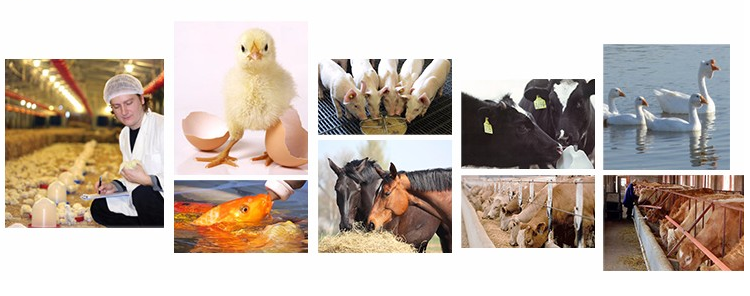
1. Application in ruminants
Adding 0.05%(dry matter based) yeast cell wall to the feed of dairy cows contaminated with aflatoxin can reduce aflatoxin in raw milk by 58% and improve milk yield and milk quality. In addition, yeast cell wall has significant effect on improving calf production level and cow health level. It was found that adding yeast cell wall to drinking milk of newborn calves at 1-35 days of age increased the growth rate by 8% and feed intake by 10% compared with the control group (P< 0,05), and the incidence of disease was also decreased.
2. Application in poultry
Generally, mycotoxin poisoning in chickens has no specific clinical symptoms. The common symptoms are poor health and lethargy. Further development can be seen in unkempt standing. However, these symptoms are easily confused with other pathological symptoms of poultry. For example, mycotoxins can affect the gastrointestinal tract and kidney of poultry, and the intestinal and intestinal epithelial cell layers are exposed to dry high concentrations of mycotoxins and their metabolites after poultry ingests mycotoxin-contaminated feed. Some toxins, especially T-2 toxins, can focus on the destruction of intestinal epithelial cells, resulting in cell necrosis, clinical manifestations of enteritis. Mycotoxins can also affect the immune function of poultry, leading to lymphoid tissue degeneration and cell depletion.
Studies have shown that ducklings are more sensitive than other poultry. It was concluded that the body weight and mortality of ducklings decreased after aflatoxin was added to the diet, but the adverse effects of aflatoxin were significantly reduced when yeast cell wall was added to the diet. Diets containing 168 mg/kg aflatoxin, 8.4mg/kg ochratoxin, 54mg/kg zearalenone and 32mg/kg kgt-2 toxin were supplemented with 0.05% yeast cell wall. The results showed that feed intake and dietary benefits of chickens without yeast cell wall were significantly reduced. In addition group, the growth inhibition caused by mycotoxin was effectively alleviated and urea nitrogen level returned to normal. In addition, yeast cell wall can improve the growth energy and efficiency of broilers, the hatching ability of meat breeding hens, and reduce the mortality rate of meat breeding hens. Adding 0.1% yeast cell wall to broiler diet can increase daily gain and reduce aflatoxin damage.
3. Application on pigs
The symptoms and severity of mycotoxin poisoning in pigs are largely dependent on the type and amount of mycotoxin present in dry feed and also on the age and production stage of pigs. In general, young pigs and breeding stock are most sensitive to mycotoxins.
The common symptoms of swine mycotoxin poisoning are: growth retardation, reduced feed conversion efficiency, increased morbidity, decreased immune function, sudden death, blood faeces, decreased fertility in sows, abortion, delayed puberty in young sows and boars, decreased libido, decreased sperm quality, and increased liver and/or kidney morbidity.
Yeast cell walls protect pigs from some of the adverse effects of mycotoxins. According to relevant studies, emitomycin or gibberellin in maize can cause weight gain loss in weaned piglets, and yeast cell wall can slow this loss. The results showed that adding 0.2% yeast cell wall in the 25% fusarium toxin contaminated corn diet can effectively increase the average daily gain and daily feed intake of pigs, and improve the utilization rate of organic matter, protein, calcium, phosphorus and other nutrients

Phone: +86-317-2135910
E-mail: Erica@stbiol.com
Address: Machang Town,Qing County ,Cangzhou City ,Hebei,China
Hebei Shuntian biotechnology Co.,Ltd.
Add:Machang Town,Qing County ,Cangzhou City ,Hebei,China
Tel: +86-317-2135910
E-mail:Erica@stbiol.com
© Copyright - 2018-2020 : All Rights Reserved.